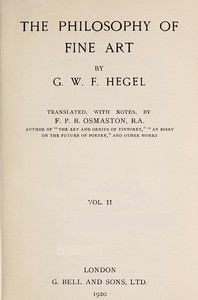The Philosophy of Fine Art, volume 2 (of 4) by Georg Wilhelm Friedrich Hegel
"The Philosophy of Fine Art, Volume 2" by Georg Wilhelm Friedrich Hegel is a philosophical treatise written in the early 19th century. This volume explores the evolution of the idea of beauty within the context of various art forms, discussing symbolic, classical, and romantic types of art. Hegel delves into metaphysics, aesthetics, and the nature of artistic expression, offering a framework to understand how art embodies and evolves the ideal. At the
start of this volume, Hegel introduces the concept of symbolism in art, framing it as both a critical phase in the evolution of artistic expression and a reflection of humanity's quest for meaning through beauty. He differentiates between unconscious symbolism, where the significance of forms is not yet fully realized, and the conscious awareness of symbols in more developed artistic traditions. Hegel posits that the early forms of art, tied closely to religious consciousness and wonder, seek to express a unity of significance and form, serving as a foundation for the subsequent expression of the human spirit in classical art and beyond. (This is an automatically generated summary.)
Read now or download (free!)
| Choose how to read this book | Url | Size | ||||
|---|---|---|---|---|---|---|
| Read online (web) | https://sendtokindle.compellingsciencefiction.com/ebooks/55445.html.images | 1.1 MB | ||||
| EPUB3 (E-readers incl. Send-to-Kindle) | https://sendtokindle.compellingsciencefiction.com/ebooks/55445.epub3.images | 705 kB |
Send
to kindle email: |
|||
| EPUB (older E-readers) | https://sendtokindle.compellingsciencefiction.com/ebooks/55445.epub.images | 720 kB | ||||
| EPUB (no images, older E-readers) | https://sendtokindle.compellingsciencefiction.com/ebooks/55445.epub.noimages | 462 kB | ||||
| Kindle | https://sendtokindle.compellingsciencefiction.com/ebooks/55445.kf8.images | 1024 kB | ||||
| older Kindles | https://sendtokindle.compellingsciencefiction.com/ebooks/55445.kindle.images | 942 kB | ||||
| Plain Text UTF-8 | https://sendtokindle.compellingsciencefiction.com/ebooks/55445.txt.utf-8 | 951 kB | ||||
| Download HTML (zip) | https://www.gutenberg.org/cache/epub/55445/pg55445-h.zip | 838 kB | ||||
| There may be more files related to this item. | ||||||
About this eBook
| Author | Hegel, Georg Wilhelm Friedrich, 1770-1831 |
|---|---|
| Translator | Osmaston, Francis Plumptre Beresford, 1857-1925 |
| Title |
The Philosophy of Fine Art, volume 2 (of 4)
Hegel's Aesthetik |
| Note | Reading ease score: 33.2 (College-level). Difficult to read. |
| Note | Wikipedia page about this book: https: //en.wikipedia.org/wiki/Lectures_on_Aesthetics |
| Credits |
Produced by Laura Natal Rodriguez and Marc D'Hooghe at
Free Literature (online soon in an extended version,also linking to free sources for education worldwide ... MOOC's, educational materials,...) Images generously made available by the Internet Archive.) |
| Language | English |
| LoC Class | N: Fine Arts |
| Subject | Aesthetics |
| Category | Text |
| EBook-No. | 55445 |
| Release Date | Aug 27, 2017 |
| Copyright Status | Public domain in the USA. |
| Downloads | 149 downloads in the last 30 days. |
| Project Gutenberg eBooks are always free! | |

